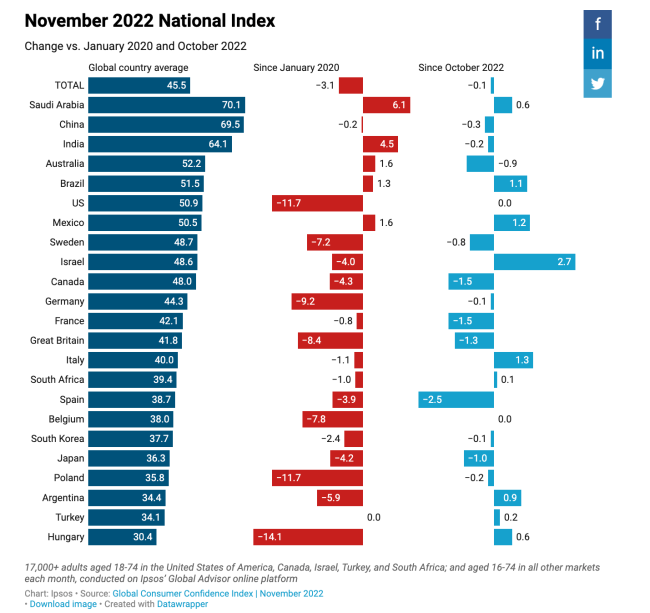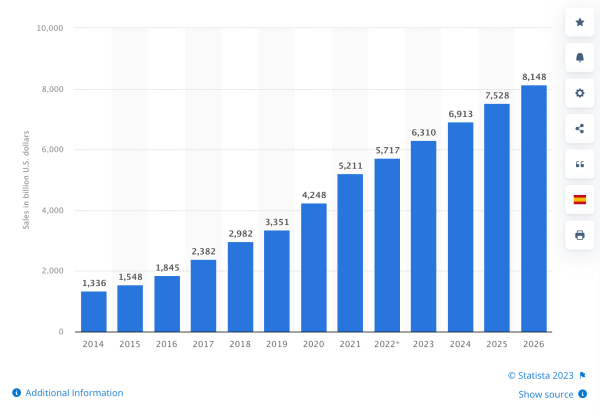We recently spoke during a webinar with Attraqt about how to innovate during a recession in order to continue growing as a business. Here is what we learned from the discussion.
TL;DR? Watch the webinar replay here.
The market’s current state
The market’s current state is quite subjective. There are a lot of different opinions and data available, given different industry sectors, but the topic of recession, economic uncertainty and what that means for how consumers are going to potentially tighten their spending both online and in-store is of importance.
Retailers held strong in terms of profits by not discounting their products in the lead up to Christmas in 2022. But it’s prevalent that they need to continue, or start maximizing their customer experience online, in-store and across any other channels to ensure that they’re in a good place throughout the next year or maybe even two.
For the past few years things have changed so much from a technological point of view, and also in regards to customer expectations and customer demand. And in terms of predictions for 2023, we’re seeing a lot of different opinions and ideas. On the one hand we hear a lot about the metaverse, digital currency, NFTs .. and on the other, headless commerce, composable architectures and omni-channel or unified journeys. But it might be more interesting for brands to concentrate on things that are definitely not going to change.
Global consumer confidence
Consumer confidence remains fairly stable as we enter 2023, and there is even opportunity for international brands to potentially maximize growth moving forward. Looking at different markets & different regions to improve upon or learn from and adopting other markets as well. There are key locations where consumer confidence is actually holding very very strong or even improving, for example Saudi Arabia, India, Australia have improved consumer confidence compared to pre pandemic. Being able to accelerate in those locations moving forward is an interesting topic.
Consumers will continue to shop online, there’s no question about that
It’s no news that cultural shifts have pushed shopping online to being the new norm, but as consuming online becomes a fully integrated part of our lifestyle, expectations are changing. The information a consumer wants to see regarding their favorite brand or the products they are shopping for is no longer limited to personalization. As humans we always expect more and we are now moving into an era of hyper-personalization. It’s more important than ever to provide for customer expectations or even surprising him or her with information he or she was not expecting.
Growth projections within e-commerce
Even though we are surrounded by economic uncertainty and quite possibly recession, statistics show that e-commerce sales are set to grow quite rapidly by 2025. Which is a huge impact in terms of growth rates since 2019.
As we mentioned, personalization has turned into hyper personalization. So how do we harness first party data? How do we listen to our customers? And how do we react upon that within trading strategies to maximize the experience for consumers online?
There’s been a rapid expansion across shopping via social channels. Understanding the omni-channel approach, how to harness social channels through in-store experience and how that data could be combined to maximize growth is an increasingly important strategy.
E-commerce isn’t going anywhere, it’s just evolving
Key trends and buzzwords within the retail sector range all the way from NFT, Metaverse, digital currency and AI to headless, composable, agile, personalized … But just how and when should each of these strategies be adopted and/or prioritized?
Taking a look at strategies with a proven positive return on investment (ROI) can make prioritizing the above trends a lot simpler. And if brands and retailers get it right, they will be able to help maximize their projected revenue growth over the coming years, in spite of a possible recession.
Where should merchants put their efforts to grow?
Acquisition is a key point
Acquiring customers has always been more expensive than retaining current customers. This is not going to change. Brands either do a blend of both strategies well or choose one or the other based on market trends or business objectives moving forward.
So whilst it may seem safer and more logical to tighten ad spending and shift focus to a growth-through-retention strategy, research shows that companies maintaining or increasing ad spend in the 1981 recession saw sales 256% higher afterwards.
Post-pandemic some brands have even seen a lucrative change. UK online sales are now at 25% up from 19% pre-pandemic. It’s an interesting shift. Continuing to focus on the best investment for the maximum return through technology going forward is key, whether your prioritise acquisition or retention.
The path to Composable Commerce
The Metaverse, Blockchain or even NFTs are clearly sexy subjects that we’d all like to invest, or at least, be involved in. But they are still in early development stages, with less than proven long term ROI. There are other ways to innovate, with a less risky investment, and faster results.
Composable Commerce is where your e-commerce platform technical stack is personalized (or composed) according to the services you wish to propose to your customers. Instead of implementing a full Suite stack that will propose a fixed list of services & integrations, some of which you don’t actually need, your stack will be based solely upon your business needs.
This kind of architecture is key right now. In an uncertain market, where you need to adapt to the customer needs or new technologies, it’s proving to be the best way to personalize the service that you’re offering to your customers and increase your time-to-market capabilities.
However, in order to implement a composable architecture, a logical first step is go headless and implement a FaaS (front-end-as-a-service).

E-Commerce replatforming: Big Bang or Progressive Migration?
First, let’s walk through the concept of a FaaS and how to reach a headless approach
In the past, and for some merchants this is still the case, brands implemented a suite solution for their backend (the backend being everything the customer does not see on the website), and a template was generated for their front-end (everything the user does see.) If you didn’t want to use the template you had to develop your website from scratch.
Frontend-as-a-service as a concept first occurred during what we call a technological rupture in the e-commerce space. APIs and new languages arrived allowing developers to actually build foundations for a front-end that could be agnostic of their back-end. Merchants could remove their front-end solution from their monolith suite, Magento for example, and replace it with a foundation that would allow them to develop much faster and gain in time-to-market.
The fact that you can plug an agnostic front-end onto your monolith back-end is not a message that is really spread to the market today and is in fact the best option for an existing e-commerce to adopt a headless commerce approach. That is to say, by separating your front-end from your back-end and replacing it with an agnostic front-end. In one fell swoop.
This concept has been created and optimized for web performance, which is generally not the case when you buy a monolith and its templates. A front-end-as-a-service will impact your web performance positively: page speed, bounce rate, conversion rate. Some of our clients have as much as doubled their online conversion rate. What’s more, the separation between the back-end and the FaaS will allow you to work on the front-end without impacting the backend.
Progressive migration & attaining a composable architecture
By removing the front-end of your existing monolith solution and connecting it to an agnostic front-end, you can go headless in around 4 months. You can continue to migrate progressively towards a composable architecture by adapting your backend for microservices. And then further down the line, add best-of-breed services.

This process will allow e-commerce agencies to gain a lot of time when building front-ends for their clients. Moreover, they’re going to be able to bring more value to their clients because they’re actually going to concentrate on what counts – such as bringing brand authenticity online, customer needs, offline connections, a frictionless website – without having to interfere with the complexity of the back-end.
To be able to adapt and make changes to your customer experience faster than ever, without depending on the technological aspects of your back-end is a game changer in today’s context.
AI & product discovery – one step further
There’s a link between AI, personalization and data exploitation and how you can automate customer experiences online. By implementing a headless or composable architecture as a foundation retailers then have the ability to then bring in best-of-breed micro-services that exploit just this.
For example, a search API or Product Discovery. An experience-led platform and tools will improve what we call relevance. By leveraging intelligent product Discovery along with data and hyper personalization they have the ability to change trading strategies rapidly.
This kind of move is key for brands that want to hold strong and maximize their performance and customer experience online. London Research studies show that 80% of brands and retailers said customers don’t really know what they’re looking for until they see the product or an interesting element of content. E-commerce brands clearly have the upper hand in this case.
Harnessing good technology to improve trading experiences and create a more relevant and accurate experience for the customer online equates to greater conversion rates, greater average order values and ultimately better bottom line revenue.
Key takeaways
- Solutions that have a proven ROI will be less risky and generate more stable growth during a recession.
- Headless commerce and a front-end-as-a-service are a good foundation for micro-servies and further platform innovation
- Simply cutting the “head” off your system and replacing it with a modern FaaS storefront that has an API layer to exchange data with microservices components is much faster and a lot cheaper.
- AI services harness existing data to improve the customer experience, such as product discovery have the ability to maximise performance and conversions



